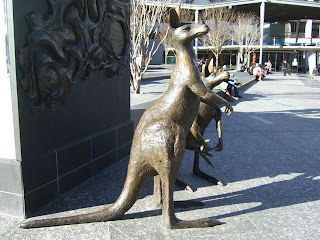 |
The new James Hutton Building, BGS Keyworth,
that includes a number of energy saving features:
photovoltaic cells on the roof, rainwater harvesting for the toilets
and a Micro-CHP (Combined Heat + Power) plant.
The building has an Energy Performance Certificate (EPC) 'A'
rating and a BREEAM'excellent' rating. |
Reading the
last issue of Nature for 2011 I was reminded of the number of events in which a detailed knowledge of the Earth system and decisions based on geological science were essential:
The world's population reached seven billion, reflecting the ever increasing need for resources to house, feed and transport humankind.
Food reached a record cost early in the year and in March the planet was struck by one of the largest earthquakes in recent times.
At the same time there was only limited progress on improvements in our ability to manage the planet into the future through agreements such as those that came out of the
climate summit in Durban in December.
In May the British Geological Survey led a discussion at the Geological Society of London on the
'Anthropocene' and asked the question about the human influence on the planet:
'is our imprint on the planet no longer reversible and if so, should we declare a new geological epoch?'
Declaration of an epoch of course also implies that this time period will have an end in which humans no longer affect the planet: we may have become extinct; we may have fled and colonised other worlds and I leave this to the reader's imagination!
Food production requires careful management of water resources, much of which comes from groundwater, and fertilisers that are mined and for which important regulation of impurities is a health factor to be considered. Desertification, deforestation and pollution of the surface and subsurface through intensive agriculture all must be carefully monitored by geologists and ecologists.
Fuel for thought
The
Tohoku earthquake, Japan was much larger than had been modelled as being probable in the region; the 'big-one' was expected to hit further south of Tokyo (and we must be mindful that this risk is still very real). This event was offshore in a known zone of tectonic plate collision, but its intensity indicates that we have much to learn about the physics of the planet.
Also we should not forget that large earthquakes (although they may be some 200 times smaller than the Japanese one) can cause incredible damage and loss of life in the interiors of continental regions and are in fact more damaging and less understood.
Although the earthquake, and the associated tsunami, killed thousands of people, the focus of attention of the world's press was on the Fukushima nuclear plant. Thankfully Fukushima is now safe, but it will take decades to clean up the site.
Many countries, including the UK, have since reviewed their nuclear power generation schemes. Nuclear technology will continue to provide a significant source of energy as we move further into the 21st century. Moving away from nuclear sources towards coal, oil and gas, the only short- medium-term replacement, only exacerbates the greenhouse gas emissions unless these are
captured and sequestered.
Storage of nuclear waste, extracting hydrocarbons, and Carbon Capture and Storage (CCS) require a very thorough understanding of the subsurface of our planet and this is the overarching role of the geologist. Further geological research and survey is essential for making the right decisions on our energy future.
Recover and recycle
In 2012, as we wait for the world's economy to recover, there will be increased demand for resources to feed, house and transport our people. While we will need new resources in strategic metals, hydrocarbons and building materials, we must focus on:
- recycling
- better insulation
- more effective transport
- renewable energy
- better water/soil/forest management etc.
For example let's think seriously about more efficient magnets in high-tech and energy applications, before we rush to mine metals from the sea-floor without a thorough understanding of the consequences.
On behalf of the staff of the British Geological Survey, I wish all of our partners and users of our geological information a very prosperous 2012.











